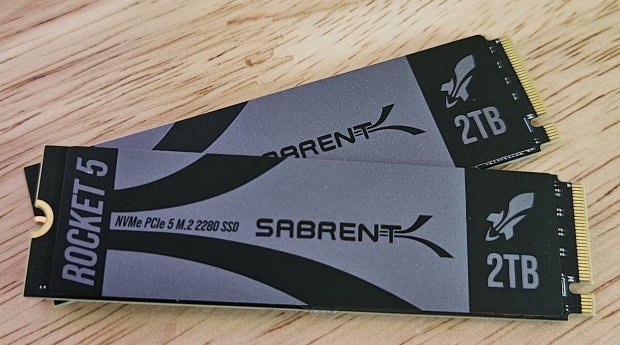Sabrent seems to be getting closer and closer to unleashing its next-gen Rocket 5 Gen 5 SSD, with the company recently testing its new Gen5 SSD under loads with temperatures hitting just 60C... and remember, that's without a gigantic heatsink that previous Gen5 SSDs not just used, but NEEDED.
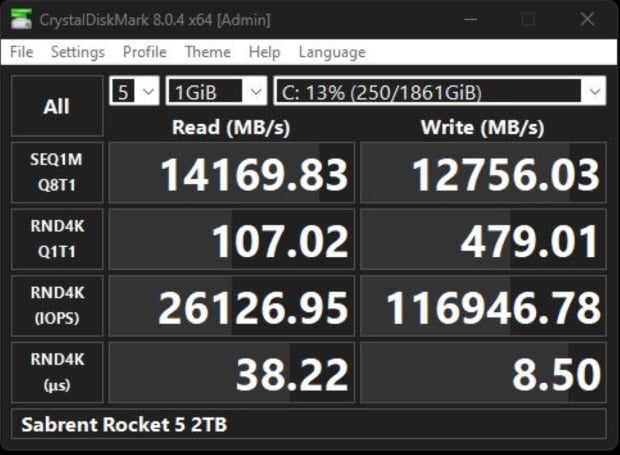
Sabrent Rocket 5 Gen 5 SSD benched in CrystalDiskMark (source: Sabrent)
The new Sabrent Rocket 5 Gen 5 SSD features Phison's impressive new E26 Max14um controller, with the companies working closely together on the new Rocket 5 SSD beast. We've already seen tests of Sabrent's new Rocket 5 Gen 5 SSD pumping 14GB/sec (14,000MB/sec) reads and 12GB/sec (12,000MB/sec) reads, but now it's been tested under new conditions with impressive thermal results.
Sabrent showed off a sample of what we can expect with the up-and-coming Rocket 5 SSD, with CrystalDiskMark benched with 14169MB/sec reads and 12756MB/sec writes.
Sabrent is aware that most users don't want to have some huge, bulking heatsink cooling their Gen5 SSD (which I totally agree with) and resulting in moving down into a Gen4 SSD. That's not necessarily bad because most people don't need 14GB/sec reads... but enthusiasts don't want to compromise. It would be like buying NVIDIA's flagship GeForce RTX 4090, but running it at full 100% load required more heatsinks and fans It's not a good look, and it's hard to push mass adoption.
- Read more: Sabrent's Rocket 5 Gen5 SSD with 14GB/sec+ speeds only needs the heatsink on your motherboard
We are learning that during the development stage with Phison, Sabrent knew that their new Rocket 5 Gen 5 SSD ran cool enough to be able to use the motherboard's built-in heatsink. Sabrent says that this was their plan all along with their Rocket 5 Gen 5 SSD, to "produce a new, faster Gen 5 SSD that did not get roasting hot while using it and force the end-user to use these massive SSD heatsinks".
William Harmon, Sr. Technical Marketing Specialist, and ex-TweakTown SSD Boss ran some tests on his "everyday rig" that he games on. Inside of this system, we have:
- Case: ASUS Hyperion
- Motherboard: ASUS ROG Maximus Z790 Extreme
- CPU: Intel Core i9-13900K
- Cooler: Arctic Liquid Freezer II 420 A-RGB
- RAM: 2x Sabrent 32GB DDR5
- GPU: ASUS ROG Strix 4090
- Monitor: SAMSUNG 57" Odyssey Neo G9
William explains that he had been running Sabrent's Rocket 4 Plus-Destroyer with 8 x Rocket 4 Plus 8TB SSDs in the second PCIe slot (that's 64TB of Gen4 SSD storage, by the way), noting that with Intel platforms PCIe lanes are scarce, so using a Gen 5 SSD meant that the GPU would drop down to just 8 lanes (down from 16 lanes) and the second PCIe slot gets disabled. William noted that he had to pull out his Destroyer to test the next-gen Sabrent Rocket 5 Gen 5 SSD.
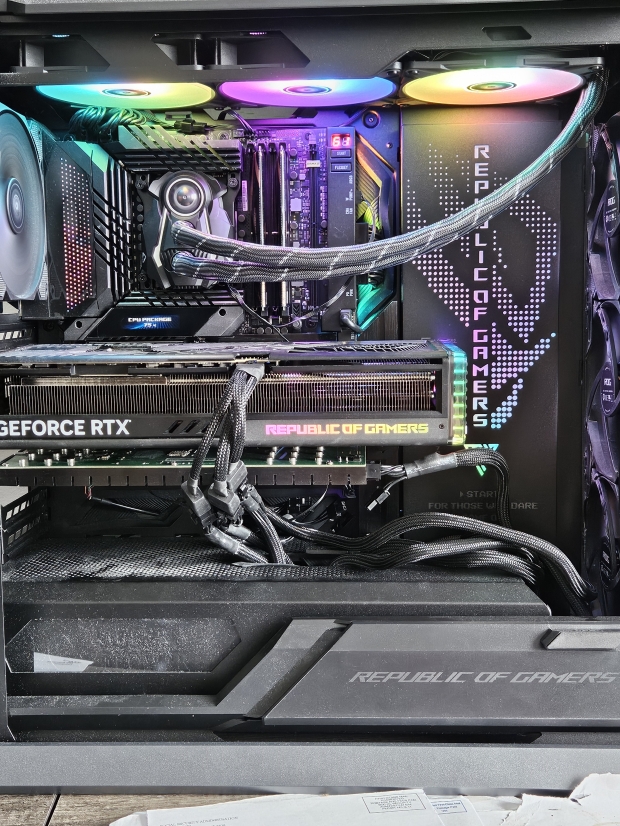
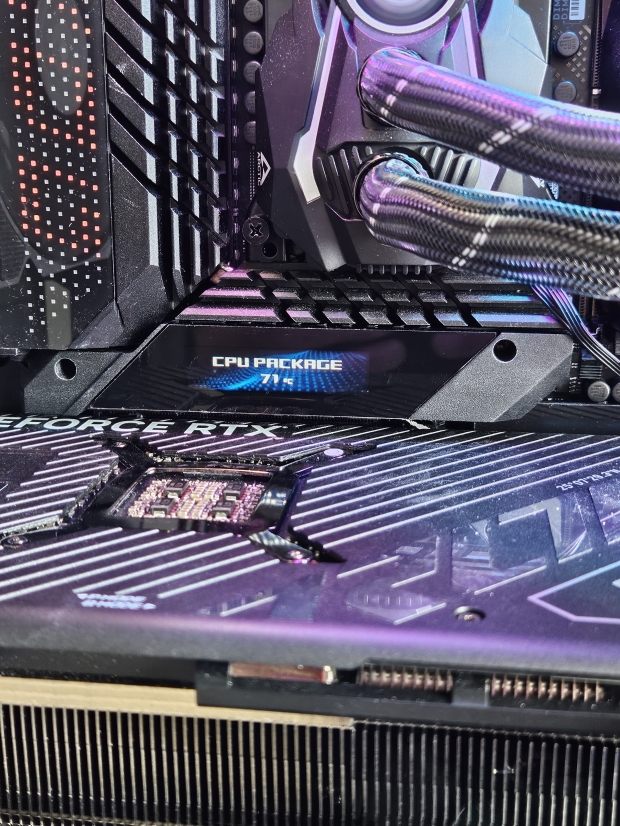
Sabrent Rocket 5 Gen 5 SSD inside the ASUS ROG Maximus Z790 (source: Sabrent)
Using his ASUS ROG Maximus Z790 Extreme motherboard and its built-in heatsink, noting that there are no other fans on the heatsink, it's just completely stock, saying that "many of the Gen 5 heatsinks would not fit".
William started by cloning his Sabrent Rocket 4 Plus-G SSD to the new Rocket 5 SSD, and then booted up from that. The temperatures that you see in the picture below are with the system at idle, with the Rocket 5 Gen 5 SSD running at 49C. He notes that this SSD is a fully loaded OS disk, with all of his apps and games installed onto the OS drive, He also noting that this isn't a benchmarking setup, just his everyday SSD for running software and games.
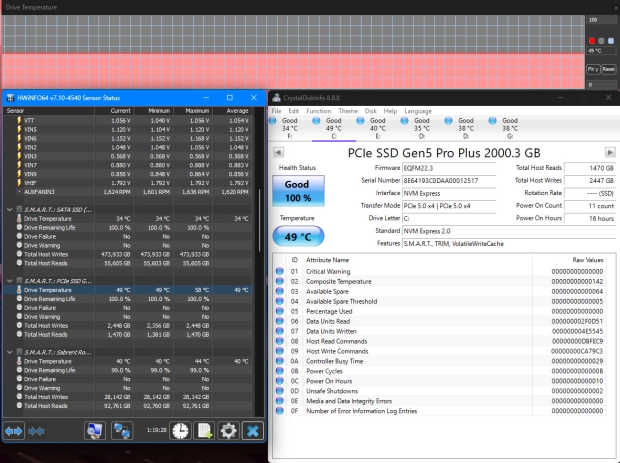
Sabrent Rocket 5 Gen 5 SSD idle temps (source: Sabrent)
William notes that the Rocket 5 Gen 5 SSD is running with idle temps of 48C to 50C, with these temps holding strong with normal workloads and games. He ran Diablo IV, Baldur's Game 3, and Starfield with temperatures not moving much while gaming.
He's running a monster Samsung Odyssey Neo G9 monitor with a native 7680 x 2160 resolution and huge 240Hz refresh rate, where he had "very playable frame rates but did notice some slight pauses during gameplay using the Rocket 4 Plus-G. With the new Rocket 5 Gen 5 SSD, those slight pauses went away".
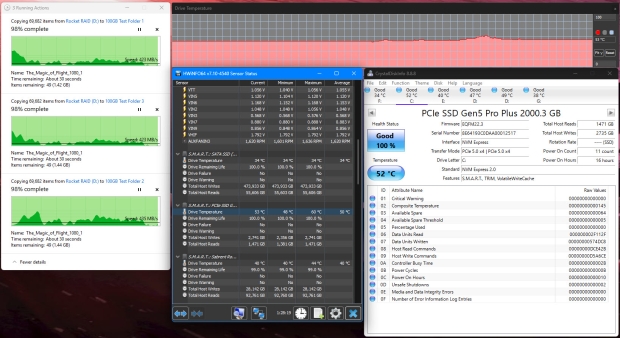
Sabrent Rocket 5 Gen 5 SSD load temps (source: Sabrent)
Next up, the Sabrent Rocket 5 Gen 5 SSD was tested with something different: file transfers. William wanted to see if he could get the Rocket 5 Gen 5 SSD running hotter, using his "normal test folder" that he uses on his benchmarking platform. William notes that this is a "bone-crushing 100GB folder with a mix of large and small files that total 62,453 files in 7,228 folders. But that wasn't enough. I created 3 folders and started copying that 100GB folder into each one for a total of 3 transfers at one time".
He notes that this is a "massive test" that normally heats up SSDs using a single folder, but using 3 folders at once is rather extreme and "far beyond what a normal user would ever do". Even in these tests, the Sabrent Rocket 5 Gen 5 SSD runs at a 60C peak for a "short bit," noting that temperatures "did slow down at the end".
This test had a huge 187,359 files inside of 21,684 folders, all done in one go. He noted that the motherboard's built-in heatsink "held up very well with this extreme test which normally brings SSDs to its knees".
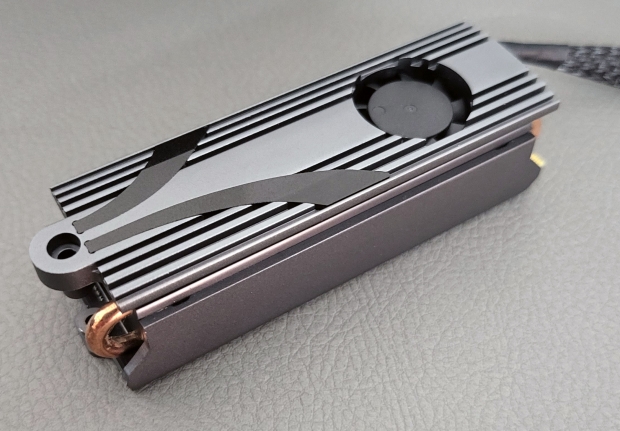
Sabrent Rocket 5 Gen 5 SSD heatsink (source: Sabrent)
However, if you want to use a heatsink with your new Rocket 5 Gen 5 SSD, Sabrent has your back. William noted: "We do have a heat sink in the works that a user can use, it's not massive in size and should be able to fit most motherboards if one wants to use it. Or on an expander card that has no cooling. I use an ASUS Hyper M.2 card on my test bench, which has a large aluminum case that works just fine. The fan on our new heat sink does not make a high pitched noise and works well for even lower temps if a user wants to use that".
The big question is when will Sabrent unleash its next-gen Rocket 5 Gen 5 SSD... with William teasing the new Sabrent Rocket 5 will "be available very soon".

